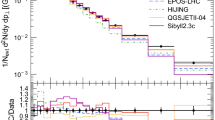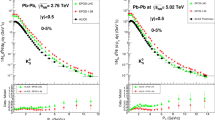Abstract
The experimental transverse momentum (pT) spectra of the strange hadrons (\(\Sigma^{ + }\), \(\overline{\Sigma }^{ + }\),\(\Sigma^{ - }\), \(\overline{\Sigma }^{ - }\) and \(\Xi^{0} + \overline{\Xi }^{0}\)) in inelastic pp collisions at \(\sqrt{s}\) = 7 TeV, measured at midrapidity range \(\left| y \right| < 0.5\) by the ALICE collaboration, are analyzed. The EPOS-LHC model calculations reproduce quite well the ALICE experimental transverse momentum distributions of all studied strange hadrons in inelastic pp collisions at \(\sqrt s\) = 7 TeV in pT region up to 5 GeV/c. The EPOS-1.99 model calculations underestimate systematically the ALICE experimental pT spectra of all studied strange hadrons, except that of \(\Xi^{0} + \overline{\Xi }^{0}\), in these pp collisions. Quite good description by the EPOS-LHC model of the experimental pT spectra of all studied strange hadrons in pT region up to 5 GeV/c could be attributed to the consistent treatment of the cross sections and the particle production in the framework of the EPOS-LHC model. The average pT of the particles from the ALICE experiment as well as EPOS-LHC + EPOS-1.99 calculations increase linearly with increasing particle mass in inelastic pp collisions at \(\sqrt s\) = 7 TeV. This is likely due to the significant collective radial flow of the particles developed in inelastic pp collisions at \(\sqrt s\) = 7 TeV. Both EPOS-LHC and EPOS-1.99 models describe quite well the mass dependencies of the experimental mean pT of the various particles in inelastic pp collisions at \(\sqrt s\) = 7 TeV. The experimental and EPOS-LHC + EPOS-1.99 model data on \(<{p}_{T}>\) versus mass dependencies of the various particles, produced in inelastic pp collisions at \(\sqrt s\) = 7 TeV, are fitted very well by a linear function with the single slope parameter. These results suggest that the collective radial flow calculations are quite adequate and very satisfactory in both EPOS-LHC and EPOS-1.99 models.




Similar content being viewed by others
Data Availability Statement
The experimental data set used for comparison with the simulated data during the current study are available at [https://www.hepdata.net/record/ins1464834]. This manuscript has associated data in a data repository. [Authors’ comment: The data has been taken from “https://doi.org/10.1140/epjc/s10052-014-3191-x”.]
References
A. Arif, Y. Ali, M.Q. Haseeb, Comparison of strange particle production measurements in central Pb–Pb collisions at \(\sqrt{{\text{s }}_{\text{N N}}}\) = 2.76 and 5.02 TeV by using Monte Carlo simulation models EPOS-1.99 and EPOS-LHC. Eur. Phys. J. Plus (2022) 137, 512. https://doi.org/10.1140/epjp/s13360-022-02739-y
G. Martinez, Advances in Quark Gluon Plasma, in Proceedings of the 2011 Joliot Curie School, September 12–17th 2011, La Colle sur Loup, France. arXiv:1304.1452v1 [nucl-ex] 4 Apr 2013 https://doi.org/10.1140/epjp/s13360-022-02739-y
ALICE, Physics Performance Report Volume I. J. Phys. G: Nucl. Part. Phys. 30, 1517 (2004)
B. Abelev, J. Adam et al. (ALICE Collaboration), Production of Σ(1385)± and Ξ(1530)0 in proton–proton collisions at √s= 7 TeV. Eur. Phys. J. C 75, 1 (2015). https://doi.org/10.1140/epjc/s10052-014-3191-x, arXiv:1406.3206 [nucl-ex]
J. Adam et al., K∗(892)0 and ϕ(1020) meson production at high transverse momentum in pp and Pb–Pb collisions at √s =2.76 TeV. Phys. Rev. C 95, 064606 (2017). https://doi.org/10.1103/PhysRevC.95.064606
J. Zhou, J. Zimányi, L. Zolin, X. Zong et al., Formation of dense partonic matter in relativistic nucleus–nucleus collisions at RHIC: experimental evaluation by the PHENIX collaboration. Nuclear Phys. A 757, 184 (2005). https://doi.org/10.1016/j.nuclphysa.2005.03.086
V. Khachatryan, A.M. Sirunyan et al., Multiplicity and rapidity dependence of Strange hadron production in pp, pPb, and PbPb collisions at the LHC. Phys. Lett. B 768, 103–129 (2017). https://doi.org/10.1016/j.physletb.2017.01.075
K. Aamodt, A.A. Quintana et al., Strange particle production in proton–proton collisions at = 0.9 TeV with ALICE at the LHC. Eur. Phys. J. C 71, 1594 (2011)
C. Shao, J. Song, F.-l Shao, Q.-b Xie, Hadron production by quark combination in central Pb+Pb collisions at s NN= 17.3 GeV. Phys. Rev. C 80, 014909 (2009)
ALICE Collab. (J. Adam et al.), Enhanced production of multi-strange hadrons in high-multiplicity proton–proton collisions. Nat. Phys. 13, 535 (2017)
S. Tripathy (For ALICE Collab.), Energy dependence of φ(1020) production at mid-rapidity in pp collisions with ALICE at the LHC. Nucl. Phys. A 982, 180 (2019)
A.K. Dash (For ALICE Collab.), Multiplicity dependence of strangeness and hadronic resonance production in pp and p-Pb collisions with ALICE at the LHC. Nucl. Phys. A 982, 467 (2019)
ALICE Collab. (S. Acharya et al.), Multiplicity dependence of light flavor hadron production in pp collisions at (snn)1/2=7 TeV, Phys. Rev. C 99, 024906 (2019). arXiv:1807.11321v2 [nucl-ex]
A. Khuntia et al., Radial flow and differential freeze-out in proton-proton collisions at (s)1/2=7 TeV at the LHC. Eur. Phys. J. A 55, 3 (2019)
M. Csanad et al., Initial energy density of (snn)1/2=7 and 8 TeV p–p collisions at LHC. Universe 3, 9 (2017)
Z.F. Jiang et al., Pseudorapidity and initial energy densities in p+p and heavy-ion collisions at RHIC and LHC. Acta Phys. Pol. Proc. Suppl. 12, 261 (2019)
S. Tripathy et al., Event shape and multiplicity dependence of freeze-out scenario and system thermodynamics in proton+proton collisions at (snn)1/2=13 TeV using PYTHIA8. Adv. High-Energy Phys. 2021, 8822524 (2021). arXiv:1905.07418v3 [hep-ph]
K. Jiang et al., Onset of radial flow in p+p collisions. Phys. Rev. C 91, 024910 (2015)
I. Bashir et al., Evidence of collective flow in p–p collisions at LHC. arXiv:1502.04185v2 [hep-ph]
I. Bashir et al., Particle transverse momentum distributions in p–p collisions at (s)1/2=09 TeV. Adv. High-Energy Phys. 2019, 8219567 (2019)
O.K. Baker, D.E. Kharzeev, Thermal radiation and entanglement in proton-proton collisions at energies available at the CERN Large Hadron Collider. Phys. Rev. D 98, 054007 (2018)
D.E. Kharzeev, E.M. Levin, Deep inelastic scattering as a probe of entanglement. Phys. Rev. D 95, 114008 (2017)
J. Bergers, S. Floerchinger, R. Venugopalan, Dynamics of entanglement in expanding quantum fields. J. High-Energy Phys. 04, 145 (2018)
J. Bergers, S. Floerchinger, R. Venugopalan, Thermal excitation spectrum from entanglement in an expanding quantum string. Phys. Lett. B 778, 442 (2018)
X. Feal, C. Pajares, R.A. Vazquez, Thermal behavior and entanglement in Pb–Pb and p−p collisions. Phys. Rev. C 99, 015205 (2019)
K. Khusniddin Olimov, F.-H. Liu, K. Musaev, M. Shodmonov, Multiplicity dependencies of midrapidity transverse momentum distributions of identified charged particles in proton–proton collisions at (s)1/2 = 7 TeV at the LHC. Universe 8, 174 (2022). https://doi.org/10.3390/universe8030174
Kh.K. Olimov et al., Multiplicity dependencies of midrapidity transverse momentum spectra of identified charged particles in p+p collisions at (s)1/2=13 TeV at LHC. Int. J. Mod. Phys. A 36, 2150149 (2021). https://doi.org/10.1142/S0217751X21501499
T. Pierog, Iu. Karpenko, J.M. Katzy, E. Yatsenko, K. Werner, EPOS LHC: test of collective hadronization with data measured at the CERN Large Hadron Collider. Phys. Rev. C 92, 034906 (2015)
E.N.E. Alexander Catalin, J.I.P.A. Alexandru, G.I.U.B.E.G.A. Lavinia–Elena, Study of Monte Carlo event generators for proton–proton collisions at LHC energies in the forward region. Chin. Phys. C 43, 083001 (2019)
V. Khachatryan, A.M. Sirunyan et al., Charged-particle nuclear modification factors in PbPb and pPb collisions at \(\sqrt{{\text{s }}_{\text{N N}}}\text{= 5.02 TeV}\). J. High Energy Phys. 4, 1–45 (2017)
ALICE Collaboration, Analysis of the apparent nuclear modification in peripheral Pb–Pb collisions at 5.02 TeV. arXiv:1805.05212 (2018)
C. Ch. Thakuria, K. Boruah, Comparison of EPOS and QGSJET-II in EAS Simulation using CORSIKA. arXiv:1202.3661 (2012)
R.M.A. Rahman, A.N. Tawfik, Y. Mahmoud et al., Rapidity distribution within Landau hydrodynamical model and EPOS event-generator at AGS, SPS, and RHIC energies. Phys. Scr. 97, 065305 (2022)
J. Welti, Inelastic, Non-diffractive and Diffractive Proton-Proton Cross-Section Measurements at the LHC (PhD thesis) (2017)
ALICE Collaboration, B. Abelev et al., Multi-strange baryon production at mid-rapidity in Pb-Pb collisions at = 2.76 TeV. Phys. Lett. B 728, 216–227 (2014), arXiv:1307.5543 [nucl-ex]. [Erratum: Phys. Lett. B 734, 409 (2014)]
E. Shuryak, I. Zahed, High-multiplicity pp and pA collisions: Hydrodynamics at its edge. Phys. Rev. C 88, 044915 (2013)
S. Acharia et al., Production of light flavored hadrons in pp collisions at 7 and 13 TeV. Eur. Phys. J. C 81, 256 (2021)
CMS Collaboration, S. Chatrchyan et al., Study of the inclusive production of charged pions, kaons, and protons in pp collisions at = 0.9, 2.76, and 7 TeV. Eur. Phys. J. C 72, 2164 (2012)
TOTEM Collaboration, T. Csorgo et al., Elastic scattering and total cross-section in p+p reactions, measured by the LHC experiment TOTEM at = 7 TeV. Progr. Theor. Phys. Suppl. 193, 180–183 (2012)
Acknowledgements
The research work of Kh.K.O has been supported by the Agency of Innovative Development of the Ministry of Higher Education, Science and Innovation of Uzbekistan within the fundamental research project No. F3-20200929146 on analysis of open data on heavy-ion collisions at the LHC.
Author information
Authors and Affiliations
Corresponding author
Rights and permissions
Springer Nature or its licensor (e.g. a society or other partner) holds exclusive rights to this article under a publishing agreement with the author(s) or other rightsholder(s); author self-archiving of the accepted manuscript version of this article is solely governed by the terms of such publishing agreement and applicable law.
About this article
Cite this article
Naseebullah, Olimov, K.K., Khan, I. et al. Analysis of production of Σ(1385)±, Ξ(1530)0 and their anti-particles in inelastic pp collisions at \(\sqrt{s}\) = 7 TeV. Eur. Phys. J. Plus 138, 556 (2023). https://doi.org/10.1140/epjp/s13360-023-04190-z
Received:
Accepted:
Published:
DOI: https://doi.org/10.1140/epjp/s13360-023-04190-z




